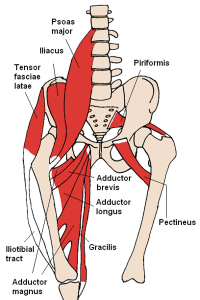Quick Takes and Short Consults- January 2011 Edition

Venus Williams
Tennis great Venus Williams is no stranger to playing injured, especially in Grand Slam matches. However, a hip flexor injury in the second round of the Australian Open proved too much for the veteran player, who was forced to retire the match in the first set against Andrea Petkovic. This marked the first time in 251 Grand Slam matches that Williams had quit with an injury. Williams told the NY Times: “I mean, it’s super disappointing because this is just not how I envisioned my Australian Open being. I’ve never had to retire from a Grand Slam, especially after working so hard to pull out the match the other day. Just hoping for some magic that I could recover. But I have peace of mind that I really gave more than my best out there.”
 The hip flexors are made up of three different muscles: the rectus femoris, psoas major, and illiacus. These muscles work together to help flex the hip, and to provide stability for the lower extremity. The rectus femoris is one of the quadriceps muscles, and also helps with knee extension. The illiopsoas group runs from the lower spine and pelvis to the femur.
The hip flexors are made up of three different muscles: the rectus femoris, psoas major, and illiacus. These muscles work together to help flex the hip, and to provide stability for the lower extremity. The rectus femoris is one of the quadriceps muscles, and also helps with knee extension. The illiopsoas group runs from the lower spine and pelvis to the femur.
The most common cause of hip flexor injury is acute trauma. The muscles can be strained during activities often during a rapid, explosive movement. Sometimes weakness in surrounding muscles, especially the abdominal core muscles, will cause the hip flexors to overwork and cause pain in these muscles. Muscle tightness and poor flexibility can also contribute to hip flexor injury.
The most common symptom of a hip flexor strain is pain, occurring along the front of the hip and radiating down the front of the thigh. Pain increases with movement, especially with lifting the knee upward. Running, jumping, and even walking can be painful, and sports performance may be limited.
Treatment consists of rest and ice packs, along with over the counter pain medications such as acetominophen, ibuprofen or naproxen. After the acute phase, exercises to increase strength and flexibility are important to prevent re-occurrence.
Zsa Zsa Gabor
 As we previously reported, 93- year-old actress Zsa Zsa Gabor was hospitalized earlier in the month and treated with strong antibiotics in an attempt to treat gangrene in her leg. Ms. Gabor had been hospitalized several times over the past several months with blood clots in her legs after a hip fracture in July 2010. Unfortunately, the antibiotics did not work, and she underwent an above-the-knee amputation of her right leg. The official statement from UCLA Hospital on Ms. Gabor stated:
As we previously reported, 93- year-old actress Zsa Zsa Gabor was hospitalized earlier in the month and treated with strong antibiotics in an attempt to treat gangrene in her leg. Ms. Gabor had been hospitalized several times over the past several months with blood clots in her legs after a hip fracture in July 2010. Unfortunately, the antibiotics did not work, and she underwent an above-the-knee amputation of her right leg. The official statement from UCLA Hospital on Ms. Gabor stated:
“Ms. Gabor needed an amputation above her knee due to poor circulation and a large ulcerated area on her right leg,” said Dr. David Rigberg, associate professor of vascular surgery at Ronald Reagan UCLA Medical Center. “After consulting with her husband, Frédéric Prinz von Anhalt, we felt this was the best medical course of action. The surgery today went well, however, she is in frail health so we will continue to monitor her closely.”
Boy, this is one tough woman!
Roger Ebert
 Last February, we wrote about an Esquire Magazine article about movie critic Roger Ebert. Ebert has undergone radical surgery to treat an aggressive thyroid cancer. Not only has his surgery left him disfigured, but is also has left him unable to speak, drink or eat. Despite this, Ebert is still smiling, and now actually has his own TV show, Ebert Presents at the Movies which debuted last night on PBS.
Last February, we wrote about an Esquire Magazine article about movie critic Roger Ebert. Ebert has undergone radical surgery to treat an aggressive thyroid cancer. Not only has his surgery left him disfigured, but is also has left him unable to speak, drink or eat. Despite this, Ebert is still smiling, and now actually has his own TV show, Ebert Presents at the Movies which debuted last night on PBS.
In preparation for this, Ebert underwent a two-year process, which has now resulted in a silicone prosthetic chin that he’ll wear during upcoming TV appearances.
Although Ebert used a voice-over by director Werner Herzog for the show last night, he has been working with speech experts on a computer program that uses voice clips from his old TV shows to give his “computer voice” a more authentic sound.
























0 comments